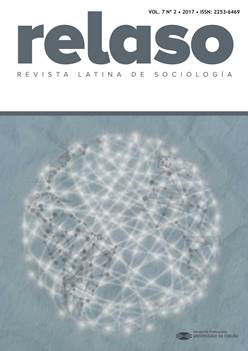Cultura moche como base de la identidad de un nacionalismo peruano
Contido principal do artigo
DOI:
https://doi.org/10.17979/relaso.2017.7.2.3056Resumo
Desde la primera mitad del s. XX, el continente americano ha sido testigo del avance del indigenismo. A través de su vertiente cultural y antropológica, el indigenismo se ha ido presentando como una corriente cada vez más consolidada y más capacitada para suplantar en el Perú a los viejos símbolos del nacionalismo. Al mismo tiempo, dada la fuerza simbólica que proyecta la civilización incaica, por su poderío militar y su vasta expansión territorial, inexorablemente se ha ido imponiendo su recuerdo para sustentar el mito que legitima el vínculo entre el Estado peruano y los sentimientos identitarios de sus naciones. Se observa así una instrumentalización cada vez más frecuente de los incas como mito del origen de la alta cultura peruana, tanto en la educación elemental, como en el marketing, en el arte o en la industria del turismo.
En el presente artículo analizaremos cómo, si bien la suplantación de los viejos símbolos resultó ser muy eficaz, el resultado de este proceso está siendo discutido por otras construcciones identitarias a través de mitos promovidos por el hallazgo y explotación de ejemplos regionales de alta cultura que pueden remontarse a tiempos anteriores al Tahuantinsuyo. Es el caso de los departamentos de La Libertad y Lambayeque, donde los proyectos arqueológicos en derredor de las culturas moche y chimú están logrando construir un modelo de sustentación identitaria que en distintos escenarios se enfrenta a la idea centralista de elevar las instituciones cusqueñas prehispánicas como el paradigma peruano de su origen.
Detalles do artigo
Referências
Alva, Walter (1988): “Discovering the New World’s Richest Unlooted Tomb”. National Geographic Society, 174, Nº4, pp. 510-555. Washington D.C.
Arrelucea, Maribel y Cosamalón, Jesús A. (2015): La presencia afrodescendiente en el Perú. Ministerio de Cultural. Lima.
Basadre, Jorge (2005): La guerra con Chile: sus orígenes y declaratoria. Lima.
Canziani, José (2003): “Estado y ciudad: revisión de la teoría sobre la sociedad Moche”. En Moche: hacia el final del milenio. Tomo II. Actas del Segundo Coloquio sobre la Cultura Moche (Trujillo, 1 al 7 de agosto de 1999) (Santiago Uceda y Elías Mújica eds.), pp. 287-311. Universidad Nacional de Trujillo - Fondo Editorial de la Pontificia Universidad Católica del Perú. Lima.
Ceruti, María Constanza (2012): “Los niños de Llullaillaco y otras momias andinas: salud, folklore, identidad”. Scripta Ethnologica, vol. XXXIV, pp. 89-104. Buenos Aires.
Dammert, Alfredo, Gallardo, José y García, Raúl (2005): Reformas estructurales en el sector eléctrico peruano. Organismo Superior de la Inversión en Energía (OSINERG). Lima.
Franco, Régulo (2008): “La Señora de Cao”. En Señores de los Reinos de la Luna (Krzysztof Makowski ed.), pp. 280-287. Fondo Editorial Banco de Crédito del Perú. Lima.
Hernández, Dilio y Chaudari, Yudi (2015): La Alianza Bolivariana para los Pueblos de Nuestra América – Tratado de Comercio de los Pueblos. Vigencia y viabilidad en el actual contexto venezolano y regional. Fundación Friedrich Ebert (FES). Caracas.
Martín, María del Carmen (2009): “La cosmovisión religiosa andina y el rito de la Capacocha”. Investigaciones sociales, vol. 13, Nº23, pp. 187-201. Lima.
Murra, John (1975): “El control vertical de un máximo de pisos ecológicos en la economía de las sociedades andinas”. En Formaciones económicas y políticas del mundo andino, pp. 59-113. Instituto de Estudios Peruanos (IEP). Lima.
Nash, Donna J. (2012): “El establecimiento de relaciones de poder a través del uso del espacio residencial en la provincia Wari de Moquegua”. Bulletin de l’Institut Français d’Études Andines, Nº 41 (1), pp. 1-34. Lima.
Pease, Franklin (1993): Perú: hombre e historia, vol. 3. La República. Fundación Edubanco. Lima.
Portal, Ismael (1917): La independencia del Perú. Librería e Imprenta Gil. Lima.
Rodríguez, Héctor; Noemí, Isabel; Cerva, José Luís; Espinoza-Navarro, Omar; Castro, María Eugenia y Castro, Mario (2011): “Análisis paleoparasitológico de la musculatura esquelética de la momia del cerro El Plomo, Chile”. Chungara, Revista de Antropología Chilena, vol. 43, Nº Especial 1, pp. 581-588. Santiago de Chile.
Rostworowski, María (1988): Historia del Tahuantinsuyu. Instituto de Estudios Peruanos (IEP). Lima.
Sanhueza, Álvaro, Pérez, Lizbet,; Díaz, Jorge,; Busel, David; Castro,
Mario y Piérola, Alejandro (2005): “Paleoradiología: estudio imagenológico del niño del cerro el plomo”. Revista Chilena de Radiología, vol. 11, Nº4, pp. 184-190. Santiago de Chile.
Shady, Ruth (2005): “Caral-Supe y su entorno natural y social en los orígenes de la civilización”. En Investigaciones Sociales, Nº 14, pp. 89-120. Lima.
Uceda, Santiago y castillo, Luis Jaime (2008): “The Mochicas”. En Handbook of South American Archaeology (Helaine Silverman y William H. Isbell eds.), pp. 707-729. Nueva York.


